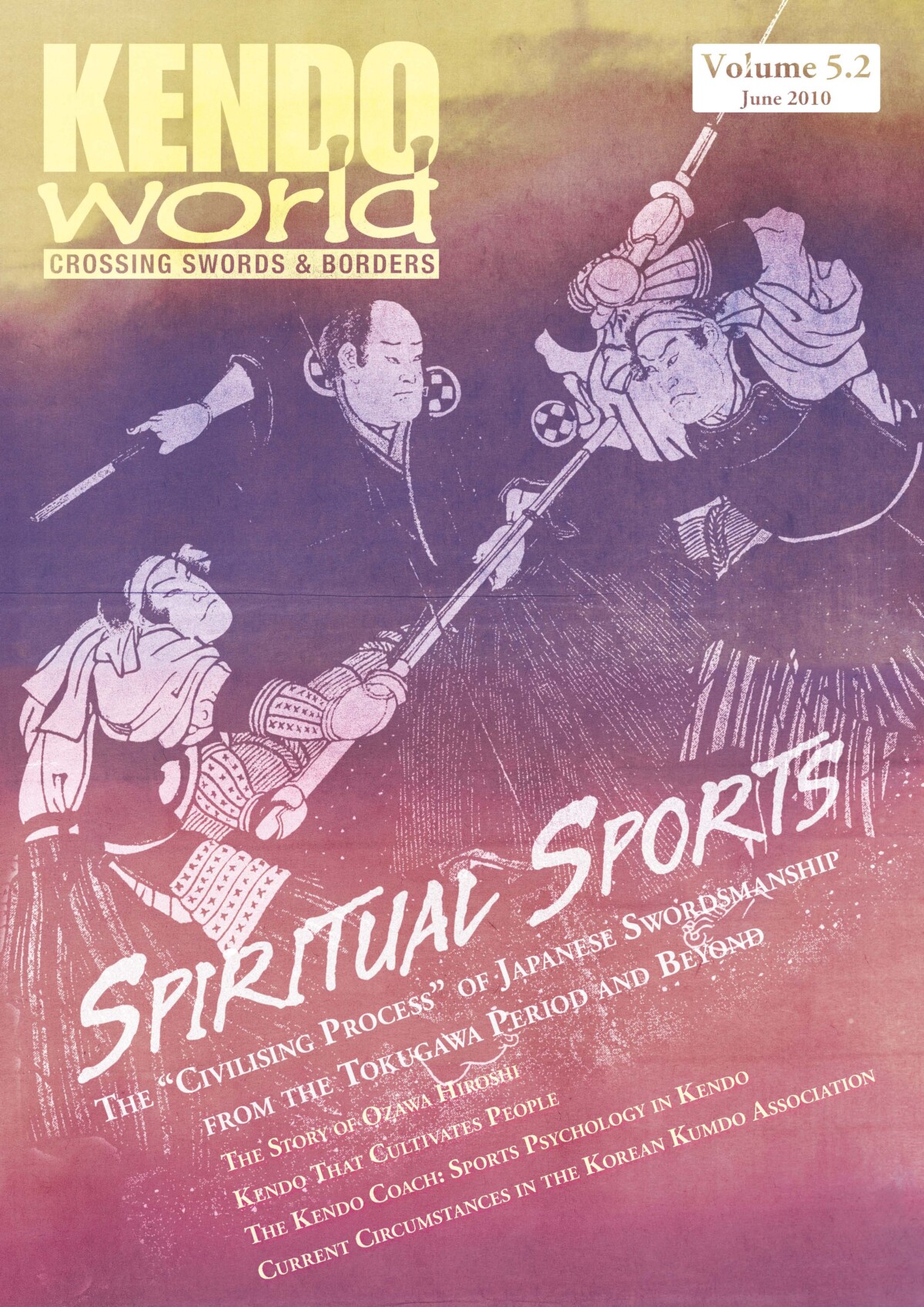
Kendo World 5.2
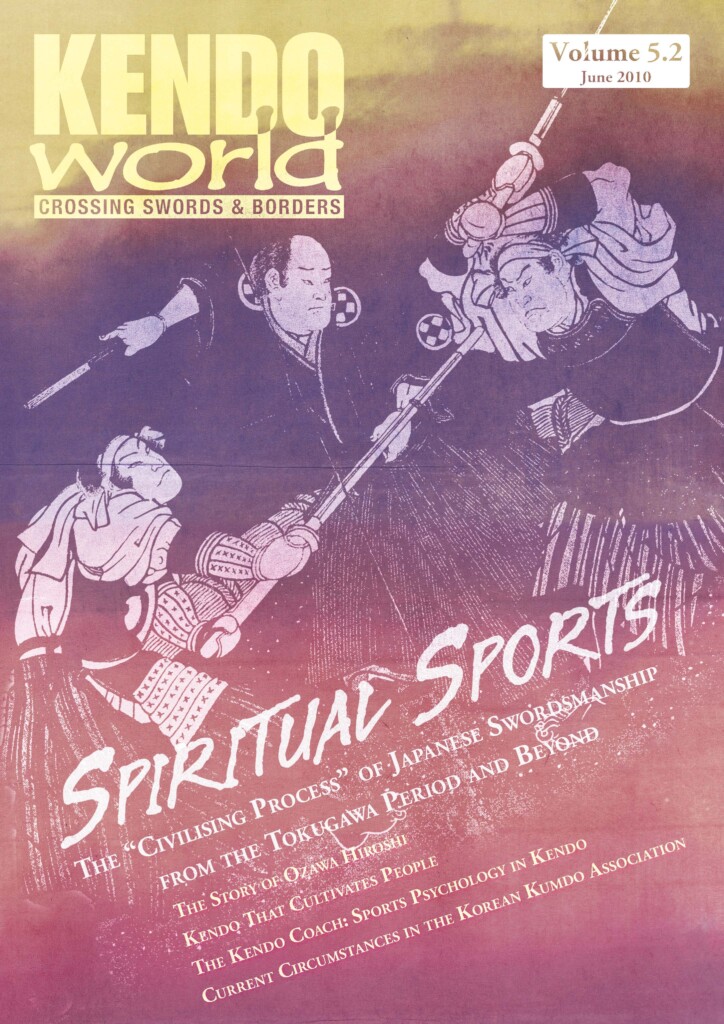
Editorial
By Alex Bennett
Bushido- Real and Invented
By Michael Ishimatsu-Prime (M.A.)
A little under forty years after the Meiji Restoration of 1868, Japan had transformed itself from a country that was vulnerable, isolated, and weak, to arguably the strongest power in the region – one that was modernizing and industrializing at an extraordinary rate. Japan also rapidly became a player on the world stage, and its arrival was signified by its victory over Russia, then one of the world’s foremost powers, in the Russo-Japanese War of 1904–1905. The successes that Japan was experiencing were attributed by some to the teachings and philosophies of “bushido”, the “Way of the Warrior”. The purpose of this article is to compare some of the Tokugawa period classics of bushidō literature by Yamaga Sokō, Daidōji Yūzan, and Yamamoto Tsunetomo with accounts of bushidō that were propagated by the likes of Nitobe Inazō, Baron Suyematsu and Okakura Yoshisaburo in the Meiji period. These modern representations of bushidō bear little resemblance to the actual code of the samurai, which was itself an ideal and far from universally practiced. The Meiji interpretations could be called “modern inventions” designed in part to define Japan’s “national identity”. These “inventions”, particularly Nitobe’s, then became the dominant portrayals of bushidō in both Japan and the West.
Hanshi Says- “You can’t do in a shinsa what you can’t do in your usual training”
By Ōta Tadanori Sensei (Hanshi 8-dan)
Ōta Tadanori Sensei was born in Chiba on January 6, 1941. He first started the study of kendo under the instruction of Fukuoka Akira Hanshi, and entered the Keishichō in 1959. After being a member of the winning team at the National Police Tournament in 1961, Ōta Sensei competed successfully at many of the prestigious kendo tournaments in Japan. He retired from the police in 2000 after serving as the Shihan for the Keishichō. He passed his 8-dan in 1990, and received the title of Hanshi in 1998. Are you getting ready for a kendo grading? Maybe these words from Ōta Sensei’s article will ring a few bells. “A trend I have noticed in promotion examinations recently is that many people seem to put on a façade and pretend to know what they are doing, but are obviously not putting enough real time into their training. If somebody asks me to give advice about ‘what’s wrong’ with their kendo, it is very difficult to answer if they have not put in the proverbial hard yards…”
Spiritual Sports Part 2:
The “Civilising Process” of Japanese Swordsmanship from the Tokugawa Period and Beyond
By Alex Bennett (Renshi 7-dan)
What makes budō so different from other genres of Japanese culture and competitive sports that it should receive such treatment in the education system? What exactly does budō have to offer and why? To answer these questions and explain the supposed benefits of participation, it is necessary to search right back to the roots of the modern martial arts and plot their evolutionary pattern up to the present day. Part 1 of this essay was published in the previous edition of Kendo World (5.1) and covered the development of Japanese swordsmanship up to the Bakumatsu era. Part 2 will look at the modernisation of kendo from the Meiji period to modern times.
Reidan-jichi Part 10: Various Issues Surrounding Seme
By Ōya Minoru (Kyōshi 7-dan)
International Budo University Professor Ōya Minoru breaks down the less tangible aspects of kendo. In this instalment, he talks about the intricacies of seme. “In simple terms, seme is the process of searching for a way to break the deadlock of kamae, and putting yourself in an advantageous situation, from where an opportunity to execute a valid strike is produced. In kendo it is often said, “win, then strike” – you must win the seme stage before executing the attack. Therefore, the way in which your opponent is coerced into moving and the influence you are able to exert on them forms the content of seme. Striking by chance or good fortune is not seme, but merely an end result.”
A Brief Overview of Pre-WWII Kendo in Brazil
By Luiz Kobayashi Ph.D.
Last year’s 14 WKC held in Brazil received ample coverage in the last issue of KW. But the roots of kendo in that country are unknown to most people, including Brazilians. Currently efforts are being made to salvage what information is still left to provide an accurate account of the art’s history in Brazil. In this fascinating article, Brazilian kendo researcher Luiz Kobayashi delves into the history of kendo in Brazil, with a specific focus on the pre-war period.
The Dai Nippon Butokukai Seitei Kenjutsu Kata
By Alex Bennett
In 1906, Watanabe Noboru chaired the first Dai Nippon Butokukai committee tasked with formulating a set of generic kata for the purpose of disseminating a unified kenjustu in schools nationwide. In August that year, he presented the culmination of the committee’s efforts to the president of the Butokukai. The Dai Nippon Butokukai Seitei Kenjutsu Kata consisted of only three forms; Jōdan (ten=heaven), Chūdan (chi=earth), and Gedan (jin=man). Now completely forgotten, this essay and explanation of the techniques is from the official text book Dai Nippon Butokukai Seitei Kenjutsu Kata published by the Butokukai. The models in the photographs were Monna Tadashi and Naitō Takaharu, both well-known instructors at the Butokukai’s specialist training school later known as the Budō Senmon Gakkō. The book was hardly used, however, as not long after its publication, the kata became obsolete. It was replaced by the Teikoku Kendō Kata in 1912, which are still practiced today as the Nippon Kendo Kata.
Teaching Kendo to Children – An Introduction for New Instructors
By Ben Sheppard (5-dan)
With its low injury rate, a structure that makes it possible for small to dominate big, and its long and captivating history, kendo is a wonderful activity for children of all ages. However, the way an instructor teaches can have a big impact on a child’s experience of kendo, and will, whether we like it or not, often be the determining factor as to whether that child becomes an adult kenshi. This article is a short guide to some of the major dos and don’ts of teaching kendo to children. It is specifically aimed at yūdanshawho are considering offering children’s classes in kendo: people who have a comprehensive knowledge of kendo fundamentals and perhaps some experience instructing adults but who have little or no experience of working with children.
4th Dan — The Movie —
By Michal Ishimatsu-Prime
Recently in the KW forums and on Facebook there has been a lot of talk about a 20-minute short film based on kendo titled 4th Dan. The film follows a kendo student, played by current Hungarian team member and 2006 national champion Szabolcs Gasparin, as he prepares for his 4-dan examination. Along the way he encounters difficulties in the form of a disapproving father, a sensei who does not believe that he is ready for the examination, and also himself. The film was released online on March 30, 2010. Director George Perrin took time out of his busy schedule to talk to KW about 4th Dan.
Principles of the Sword Part 5- Bushido – Just Another Anachronism?
By Dr. Stefan Maeder
As some chivalrous principles are still alive in the martial arts of Japan, it is obvious that a contemporary and comparative re-evaluation of bushidō values could serve not only as an ethical foundation for the martial way of kendo, and also as an emergency brake for questionable tendencies seen in modern civilisations. Dr. Maeder offers some thoughts on the relevance of kendo in the modern era.
Women’s Kendo in the Lands of Diversity
By Carla Sánchez (Ecuador Kendo Federation)
If you are a female beginner from any country in Latin America, except Brazil, you are certainly part of a minority in kendo, and you should have a deep admiration for the women from Brazil. It is very difficult to learn from their kendo except in tournaments, in which they always get first-place. Sharing their experience and knowledge by training together with them was priceless, just as it was being taught by Kim Sensei. She was able to teach lessons that go further than physical and technical matters. It may have been a once in a lifetime opportunity for most of the women from Peru, Aruba and Ecuador, just as it was for me.
Reaching the Pinnacle, with Helping Hands from Afar
By Paul H.B. Shin (4-dan), Photos by Aram E. Kailian (3-dan)
Passing the notoriously difficult kendo 8-dan exam in Japan is a remarkable achievement by any measure – a validation that a kendoist has risen above the top tier of hardened 7-dan peers. But pulling off the feat without the benefit of frequent practices with 8-dan mentors is the kendo equivalent of pulling oneself up by the bootstraps. That’s what Shozo Kato Sensei did in Kyoto this May at the age of fifty-four, becoming the third person from outside of Japan to pass the 8-dan test administered by the All Japan Kendo Federation (AJKF). Paul Shin, a student at Kato Sensei’s Dojo, investigates what it takes to reach the pinnacle in the world of kendo.
The Process of Making Japanese Swords: Part 3
By Mikami Sadanao (Swordsmith), Translated by Nick Mathys
Illustrations courtesy of the late Nagayama Kōkan (Former National Living Treasure)
The Japanese sword used to be called the ‘soul of a bushi’. It was both the weapon by which bushi protected themselves as well as being one of their sources of spiritual strength. Yet, in today’s world, it is not acceptable to possess katana as weapons and they serve a sole purpose as works of art to be admired. They are endowed with an exquisiteness that has earned them the accolade of ‘steel works of art’ and, as such, demand careful attention from both their owners, and those handling them. This is the last instalment in this fascinating series of articles that explains everything you need to know about the exquisite Japanese sword.
The Nuts ‘n Bolts of Kendo – Striking Opportunities & San-Sappo
By Nakano Yasoji, (Hanshi 9-dan)
In this issue, legendary kendo master Nakano Yasoji Sensei discusses the ins and outs of the important concept of ‘san-sappō’, that is to ‘kill’ the opponent’s sword, technique and spirit. “I always say to ‘kill the sword with the sword, waza with waza, and kiwith ki.’ If your opponent assails you with strong ki, you will not be able to defeat them with waza if you are weak-kneed. You have to meet them with your spirit and take the challenge head-on. Kendo is not just a tit-for-tat exchange of strikes with a bamboo stick. Feeling and spirit is of crucial importance, and must be nurtured of the course of your training. Nevertheless, the vivacity of kiai is not dictated by the number of decibels…”
Kendo That Cultivates People – Part 10: The Role of Keiko at ‘Tanren-ki’ Level
by Sumi Masatake (Hanshi 8-dan) Translated by Honda Sōtarō
In previous instalments Sumi Sensei covered instructional points and types of keiko for students in their early teens to late twenties (tanren-ki). In this issue, he considers the role of shiai in kendo, and how to practice for shiai. “Competitive skills should never be the entire focus of one’s kendo training; a point that instructors should keep firmly in mind. The student runs the risk of becoming engrossed with success and being deeply disappointed by failure, thereby sacrificing the chance to cultivate their character. On the other hand, the pressures associated with competition do offer other valuable experiences and opportunities for development. In this instalment I will describe how to cultivate the character through shiai experience as I believe that the over-frequency of competitions is having a negative impact on kendo. Kendo practitioners must be made aware of the proper role that shiai and shiai practice should play in their training…”
A Duffle Bag & a Bogu Bag – Part 5: The Way of the Sword in Guatemala
By Imafuji Masahiro (5-dan)
Ten years have passed since the Masahiro first travelled to Guatemala in 2000, on a governmental program called the “Japan Overseas Cooperation Volunteers” (JICA). At the time, he was the second volunteer to assume the task of “teaching and promoting kendo” in Guatemala. In May 2010, he re-visited his old mates in Guatemala and could not believe the progress they had made in his absence. It seems that in his absence, even the Guatemalan police have incorporated kendo in to their training regime…
Book Mark
Origins of a Legend: The Real Musashi – The Bushu Denraiki
Translated and Annotated by William De Lange
Review by Jeff Broderick
The publication of Origins of a Legend: The Real Musashi – The Bushu Denraiki is a real cause for celebration for anyone interested in the truth of Musashi’s life. William De Lange has translated and added commentary on the Bushū Denraiki, which he convincingly argues is the most reliable of the four main biographies made by direct students in Musashi’s Niten Ichi-ryū tradition of swordsmanship. Jeff Broderick assesses the merits of this important new book for the martial arts aficionado.
Shinai Sagas: The Fifth Poison
By Charlie Kondek
It is said that in kendo there are four ‘poisons’ of the mind: fear, doubt, surprise and confusion. Charlie Kondek, accomplished writer and experienced kendo buff, believes there is also a fifth poison – discouragement… “What, then, is discouragement? Discouragement is simply this – giving up. It is the gentlest of poisons and the one that stays in you the longest. Fear will pass, you can suppress doubt. You will recover from surprise and you can step away from confusion. But discouragement leaves a deeper wound and settles down into the core of a kenshi, there to reside for a while, walking around with you like a serpent curled at the base of a tree…”
The Kendo Coach – Sports Psychology in Kendo Part: 3 “Attentional Focus”
By Blake Bennett (5-dan)
The previous article by qualified sports coaching expert Blake Bennett, dealt with the concept of competitive anxiety, and also provided some of the many PST (psychological skills training) methods available to manage anxiety in a high pressure kendo environment. Continuing in this direction, in this article he examines another one of the so-called ‘big 3’ important mental skills to develop for optimal performance – ‘attentional focus’. With the inclusion of practical strategies to employ in regular trainings, this article seeks to assist the kendo coach in expanding their box of training tools even further by summarising the sports psychology literature on the concepts of “attention” and “concentration”, and describing when and why effective focus techniques is deemed so important to performance.
Naginata Technical Special– Part 8: Hachihon-me
By Alex Bennett
The basic kihon moves in naginata are combined in eight set patterns called shikake-ōji. By practising shikake-ōji in pairs, the practitioner is able to learn correct etiquette, kamae (stances), grip, footwork and body movement, maai (distance), breathing technique, striking chances, zanshin (mental and physical state of alertness), correct posture and so on. Shikake-ōji is also a competition event in engi-kyōgi. This instalment is an explanation of the eighth and final form, hachihon-me.
It’s not the Hokey Cokey
By Stuart Gibson (4-dan)
Or “Hokey Pokey”, if you are that way inclined. This is how ex-pat UK kendo representative Stuart Gibson sees how many people understand “seme” back home. “You put your right foot in, and you shake it all about, and then instead of turning around you attack men, regardless of what the opponent is doing. You might as well have actually turned around and completed the Hokey Cokey…”
sWords of Wisdom
“Muso-no-ken” (The sword of no-contemplation) of Itō Ittōsai
By Alex Bennett
Itō Ittōsai’s Ittō-ryū is recognised as being one of the most influential sword schools in history, with many of the teachings influencing the way we do kendo today. “Even in a state of sleep, a man with an itchy foot will not scratch his head. If there is an itch on his foot, he will scratch the foot. If it is the head that is itchy, it is the head that he will scratch…” What does this mean? You’ll have to read the article to find out.
Kumdo Demystified
By Aurélien Lainé
After living and studying kendo in New Zealand for a number of years, Frenchman Aurélien Lainé has been in South Korea for six months now, and has been privileged to discover kumdo right at its source. “To understand the Korean approach to kumdo, it is first important to look at South Korea’s attitude towards competitiveness. Although I am not an expert in South Korean studies, I will try to depict what seems to me to be a truthful image of kumdo in Korea…” Are they really the same, or fundamentally different?
Jukendo no Kata – Part II: Mokujū tai Tō-no-Kata
By Baptiste Tavernier
Jukendo-no-Kata’s ultimate purpose is to impart the essence of jukendo. The forms combine the basic techniques with a fixed order, and through learning the combination of techniques, students of jukendo develop a strong spirit, good posture and technical ability. The Mokujū-tai-Tō-no-Kata consists of six sets, which can be divided into two groups of three. From ippon-me to sanbon-me, the bayonet overcomes the sword. From yohon-me to roppon-me, the sword prevails. Long time naginata and jukendo practitioner Baptiste Tavernier takes us through the kata of this fascinating martial art.
Zen and the Martial Arts
By Thomas Kirchner
The relation between Zen and the budō (martial arts) is a subject that has attracted much attention in both the East and the West. Many of the budō trace their origins in one way or another back to Bodhidharma, the sixth-century patriarch of Chinese Zen, and link their traditions to Zen through their relationship with bushidō. Several Zen masters, most notably Takuan Sōhō in the seventeenth century, have written at length on the relation between kenjutsu and Zen, and a number of martial arts masters, including the famous swordsman Yamaoka Tesshū and Ōmori Sōgen, also mastered the practice of Zen meditation. Thomas Kirchner, the well-known American Zen priest resident in Kyoto ponders the relationship between Zen and the martial arts.
Unclocking Japan – The Idiot Box
By Lockie Jackson Ph.D.
It’s been called “chewing gum for the eyes” (American architect Frank Lloyd Wright) and “the drug of the nation” (Hip-hop group Disposable Heroes of Hiphoprisy). US advice columnist Ann Landers is reputed to have pronounced that its existence “proves that people will look at anything rather than each other”. Some people can’t get enough of it, while others loath it. That’s right folks, the theme for this issue’s “Unlocking Japan” is Japanese television.
Miyako Kendogu
Introducing Andy Fisher (UK Team Captain) and his bōgu business in Kyoto. “The idea behind Miyako Kendogu is to provide the non-Japanese speaking customer with the same privileges as fluent kendōka, to access the best quality hand-stitched or machine made bōgu, with the option to customize.”
AVAILABLE ON KINDLE AND THE BUDO BOOKS APP IN E-BOOK FORMAT! SEE THE LINKS BELOW!!






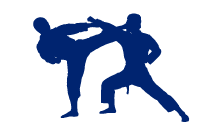

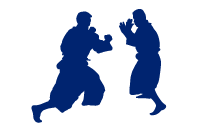

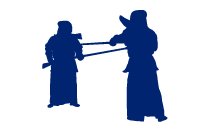


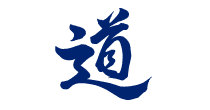




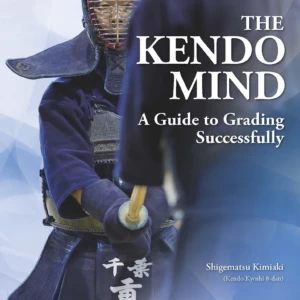
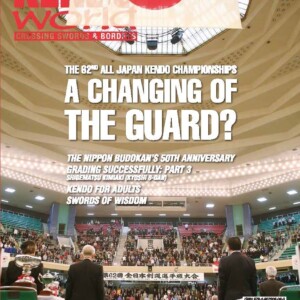
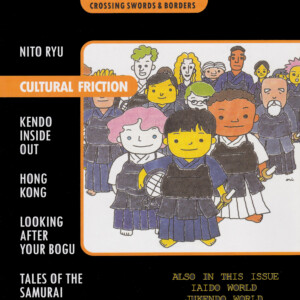
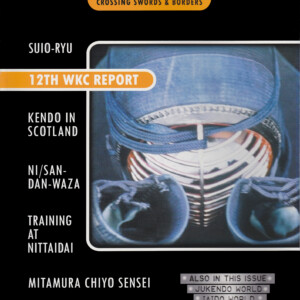
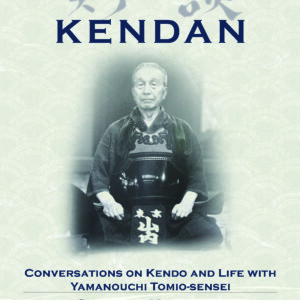
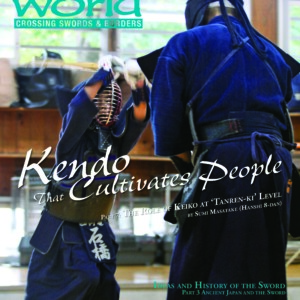
No comments yet.